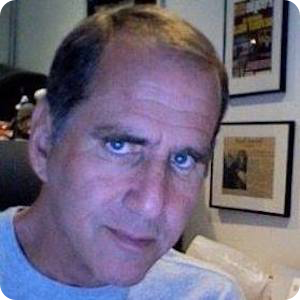
The question at the trials was why?
During the seven months before the brothers were arrested, the media speculated it was a mob hit connected to their father’s home video business.
My original assignment for the Miami Herald in December 1989 was to write a 5000-word biography of Jose Menendez’s rags-to-riches story that ended in tragedy.
I spent two days interviewing Erik and Lyle Menendez two months after the murders and five months before they were arrested.
They weren’t suspects publicly and I had no reason to be suspicious of them. They were emotionally appropriate and told me loving stories about how much they missed their parents. The Menendez murders didn’t make the cover of People until their arrest in March 1990.
The L.A. County DA’s office immediately put out the spin: “greedy rich kids killed Ozzie and Harriet” on a Sunday night in Beverly Hills.
The mainstream media ran with that until the case went to trial in July 1993 — 25 years ago this summer.
It was long before the Internet and the 24-hour news cycle.
The defense didn’t go public with their story until two weeks before opening statements:
Erik and Lyle had been physically, emotionally, and verbally abused – there were eyewitnesses to that.
And in their powerful testimony, the brothers said they’d been sexually molested by their father and killed in fear when they threatened to expose him.
A new cable channel, Court TV, carried the first trial gavel to gavel from July 1993 to January 1994. People in the U.S. and around the world followed the case obsessively like a telenovela. Jay Leno made nightly Menendez jokes just as he did during OJ’s trial. Harvard law professor Allan Dershowitz mocked their defense as “The Abuse Excuse.”
The public was outraged when two juries – one for each brother – came back hung.
Most of the women voted for manslaughter – a lesser form of murder that still carries an 11-year sentence in California for each count. All the men voted for murder.
The public was furious.
Why couldn’t the juries convict if the brothers had admitted they killed their parents?
But the defense had put on 65 teachers, coaches, friends and relatives who told the story of a pair of dysfunctional parents and two troubled sons who were spinning out of control.
On the outside, the façade was perfect:
- A successful Hollywood executive.
- His beauty queen wife.
- Two sons at Princeton and UCLA who were nationally ranked tennis players.
But the reality behind the gates of the mansion in Beverly Hills was a nightmare.
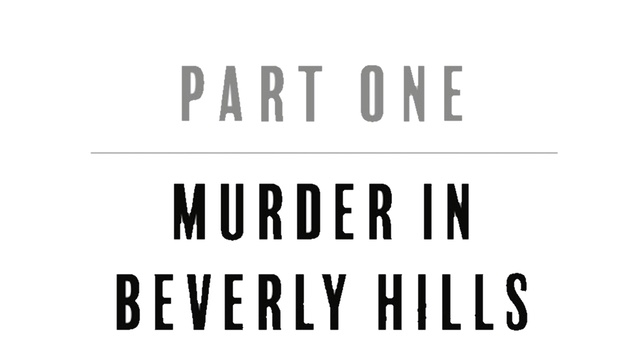
NIGHTMARE ON ELM DRIVE
I think that possibly if Lyle and I would have been home, . . . if we would’ve been able to do something about it, maybe . . . uh, maybe my dad would be alive. Uh, maybe I’d be dead. You know, I mean, I don’t know. I-I-I wish . . . I definitely would give my life for my dad’s.
— Erik Menendez speaking to author in October 1989, two months after the death of Jose and Kitty Menendez
On the night of August 20, 1989, the last in the lives of Jose and Kitty Menendez, their elegant residential street in Beverly Hills was so still you could hear a leaf drop. That in itself was not unusual or suspicious. People pay a steep price to live in such neighborhoods, and they cherish their peace and quiet.
That particular Sunday was a leisurely, relaxed day around the house for the Menendezes, an affluent couple in their mid-forties. Jose, a powerfully built, handsome Cuban emigre who left Havana at age sixteen, was the chief executive of LIVE Entertainment, a leading Hollywood home video distributor. He sat on the board of LIVE’s parent company, Carolco Pictures, producer of the Rambo and Terminator movies. Mary Louise, who’d been called “Kitty” since she was a child, was a stay-at-homemother.
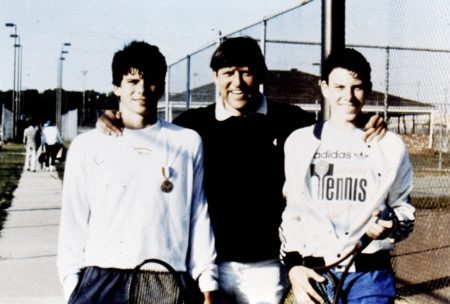
Jose Menendez gave Lyle (L) and Erik (R) intensive tennis lessons from a very young age. This photo of father and sons was taken in Princeton, New Jersey, in the mid-1980s.
Their two college-age sons, Erik and Lyle, spent the day swimming and playing tennis behind the family’s lushly landscaped 9,000-square-foot, eight-bedroom beige Mediterranean-style mansion at 722 North Elm Drive in a fashionable neighborhood just below Sunset Boulevard. Eight months earlier, the Menendez family had moved to Beverly Hills from Calabasas, a suburb northwest of Los Angeles. Before that, they’d spent a dozen years living in the Princeton, New Jersey, area.
In June 1989, eighteen-year-old Erik graduated from Beverly Hills High School. He was about to enroll at the University of California Los Angeles and planned to commute to UCLA’s nearby Westwood campus. Twenty-one-year-old Lyle was a student at Princeton University. Both young men were highly-ranked amateur tennis players with professional aspirations.

When Perry Berman arrived at his West Hollywood apartment just after 1 pm, on August 20, 1989, there was an answering machine message from Lyle Menendez. Berman, a friend and former tennis coach of the brothers, had frequently met them for movies or dinner since moving to California from New Jersey. When Berman returned the call, Jose Menendez told him Erik and Lyle were out shopping at the Beverly Center, a nearby upscale shopping mall.
Lyle called Berman back around 5 pm and suggested they get together that evening. Berman was planning to attend the Taste of L.A., a food festival in Santa Monica. He was leaving within the hour and invited Erik and Lyle to join him and a friend, Todd Hall. The brothers were going to the movies, said Lyle, to see Batman. He suggested they all meet about 10 pm at the food festival.
After eating dinner at home, the brothers walked out the back gate to Erik’s white Ford Escort parked in an alley behind the property and drove to the AMC multiplex at Century City Shopping Center. Around 10 pm, Jose and Kitty were settled in the family room watching a James Bond movie, The Spy Who Loved Me, on a big-screen TV. It was the housekeeper’s night off, and they were spending a rare evening alone. People close to the family said the couple’s marriage appeared to be improving lately. One relative noticed they were holding hands again, something she hadn’t seen since their college days.
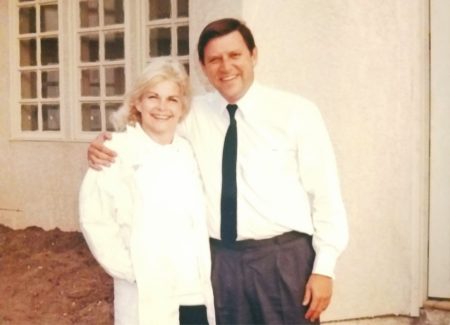
The last known picture of Kitty and Jose Menendez, taken outside their Calabasas, California, dream house in early August 1989—a couple of weeks before they were killed by their sons.
As he watched the movie, Jose Menendez put his feet up on the coffee table and started to doze off. Kitty was seated next to him.
The house was equipped with an alarm system, but Jose rarely turned it on.
His sons were always setting it off by accident. Besides, he felt safe in Beverly Hills.
The French doors behind the couch were closed.
Just after 10 pm, a neighbor, Avrille Krom, heard “popping sounds” like Chinese firecrackers quickly going off in a row.
Krom noted the time because she was anxiously waiting for her daughter Jennifer to return at 10:30 from a neighbor’s house. Her twelve-year-old son, Josh, was watching a TV movie. He wanted to call 911, but his mother didn’t think anything of this noise that barely interrupted the crickets’ chirping. The idea of gunshots just didn’t fit in this neighborhood. But it wasn’t firecrackers.
Two people had burst into the Menendez family room through the double doors located off the foyer and begun firing 12-gauge Mossberg shotguns. One of the intruders walked around the back of the couch, put the barrel of the massive gun to the back of Jose’s head, and pulled the trigger.
Kitty, terror-stricken, turned to find another gun near her mouth. Instinctively, she jumped up and raised a hand to protect herself, but to no avail; a blast catapulted her onto the floor.
What transpired in that once welcoming family room was a brutal slaughter of a ferocity rarely seen outside the fields of war.
There was blood spatter covering the couch, on the wall, on the wood window louvers, on the coffee table, and throughout the room. Wielding pump-action shotguns — as opposed to automatic weapons — the killers chose to stand in place and methodically pump shell after shell into the helpless couple.
Five blasts hit Jose. In addition to the point-blank shot to his head, he was struck in the chest, upper arm, and left elbow. A “through and through” wound of his left thigh left a gash three inches around. In the robotized language of his autopsy, the “brain had been predominantly eviscerated” by the “explosive decapitation” of the gaping gunshot wound.
Kitty tried to escape from her attackers but was found lying on her right side, a few feet away from her husband’s feet, her face an unrecognizable, gelatinous mass. Every bone in her face was broken. Most of her teeth were shattered. She was ripped apart by nine, possibly ten shots. One almost severed her right thumb. Her left leg, with a large wound at the knee, was broken and bent at a 45-degree angle. Her right leg was stretched out along the bottom shelf of the coffee table. Kitty’s sweatshirt and pants were soaked with blood.
Across town in Santa Monica, Perry Berman and Todd Hall left the Taste of L.A. at 10:20 pm. Erik and Lyle Menendez never arrived. Perry Berman was already in bed when his phone rang fifteen minutes later. Lyle Menendez wanted to know why he hadn’t been at the food festival. Perry explained he’d waited until almost 10:30 pm. “What happened to you guys?” he asked. “We got lost,” replied Lyle. “We decided to drive downtown because we thought it was on Fourth Street in downtown Los Angeles.” After realizing they were in the wrong place, said Lyle, the brothers turned around and drove west on the Santa Monica Freeway, arriving at the festival much later than expected.

“I feel bad we weren’t able to get together, but let’s go out during the week,” said Perry. Lyle sounded apprehensive. He insisted he had to see Berman right away to discuss his tennis game as well as his plan to return to Princeton in September.
         
“Fine,” said Berman reluctantly. “If it’s that important to you, I’ll meet you in half an hour at the Cheesecake Factory in Beverly Hills.” Berman barely had time to get out of bed before Lyle called back. It would be better, he said, to meet at the Menendez mansion. Erik needed to pick up his fake ID so they could all have some beers. “Absolutely not,” said Berman. “I’ll give you an extra ten minutes to pick up the ID and meet you at the Cheesecake Factory.”
When Erik and Lyle pulled up outside their home just after 11:30 pm, the electric gate on the black wrought iron fence surrounding the property was open. The front door was unlocked. The brothers later told police they thought their parents might be out walking the dogs since their two Mercedes — one of them on loan from a local shop while one of the family’s cars was being serviced — were in the courtyard next to Lyle’s red Alfa Romeo. The lights in the two-story entry foyer were on. The first thing they noticed inside was a gray cloud of smoke hanging lazily in the air.
It was a routine Sunday evening for the two operators monitoring 911 calls at Beverly Hills Police Department headquarters.
The phones had been silent for over half an hour when BHPD dispatcher Christine Nye answered a call from a distraught young man at 11:47 pm:
Dispatch: Beverly Hills emergency.
Caller: Yes, police, uh . . . (Scream in background): No!
Dispatch: What’s the problem?
Caller: (sobbing) Somebody killed my parents! Dispatch: Pardon me?
Caller: Somebody killed my parents!
Dispatch: What? Who? Are they still there?
Caller: Yes.
Dispatch: The people who . . .
Caller: No …No …(sobs) …
Dispatch: Were they shot?
Caller: Erik …man …stay …
Dispatch: Were they shot?
Caller: Yes!
Dispatch: They were shot?
Caller: Yes . . . (sobbing)
Dispatch: (dispatching police units)
Two minutes after the 911 call, Beverly Hills patrol officer Mike Butkus and his partner John Czarnocki received an urgent dispatch:
Reported shooting at a residence. Approach with extreme caution. Shooters may still be present!
Turning north off Santa Monica Boulevard onto Elm Drive, they quietly drove past the Menendez mansion. After parking two doors away, they silently watched the house from outside the open front gate.
Suddenly, the patrolmen heard screaming inside. A moment later, two young men came running out the front door, side by side, directly toward the officers. A startled Butkus ordered the pair to “sit down and get on the ground.” The men complied immediately. The only illumination came from the old-fashioned streetlamps that look charming but shed little light. Butkus didn’t notice any blood on their clothes.
Erik and Lyle Menendez appeared to be distraught.
“Oh, my god, I can’t believe it! Oh, my god, I can’t believe it!” they screamed repeatedly.
At one point, having stood up, the brothers dropped to their hands and knees and began pounding the ground with their fists. For several minutes, Butkus couldn’t get a coherent word out of them. Suddenly, they frantically pointed at the house and made an anguished plea: “Just go see. Go in and see!”
Perry Berman was early when he pulled up to the Cheesecake Factory just past 11:30 pm. He sat in his car waiting. A few minutes later, Berman went inside and saw people vacuuming carpets and cleaning tables. He asked if anyone had seen two young men come in, describing them as about twenty years old, dark hair, six feet tall. “No, not at all in the last hour,” a hostess told him.
When he walked outside, Berman heard the high-pitched shriek of police sirens and decided to drive over to the Menendez mansion. As he turned onto North Elm Drive, Berman was startled to see police cars with flashing lights up and down the street.

He became extremely alarmed when he saw officers with drawn guns crouched behind the trees of the Menendezes’ neighbors.
         
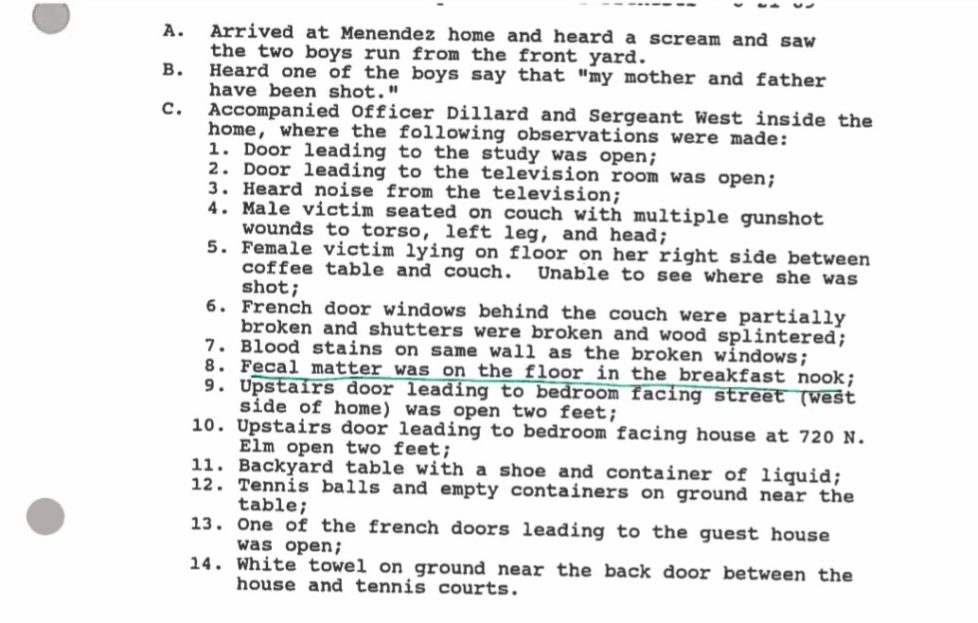
Investigators thought there might still be suspects hiding inside the mansion and decided to send a search party through the house. When the search team entered the marble foyer, they observed athletic bags and clothes dropped haphazardly on the floor. To the left of the front door was a small wood-paneled sitting room.
As one officer watched the front door and stairwell, the rest of the group cautiously made a sweep of the formal living room with their flashlights. Sgt. Kirk West approached the family room at the end of the hallway. Some lights were on, and West thought he heard a TV or radio. He made a quick visual check of the bodies. Both had multiple gunshot wounds to the head and chest. West didn’t have to touch them. He knew they were dead. The size of the wounds made it obvious that a shotgun had been used in the attack, although there were no expended shells on the gold Oriental rug or polished parquet floor.
Veteran homicide investigators say that the average person who walks into a house and discovers two brutally murdered bodies will run outside immediately and call police from a neighbor’s phone.
Most people are afraid the killer might still be there. Still, Erik and Lyle’s emotional distress appeared to be genuine.
Because of their compassion for the agitated brothers, detectives decided to forego routine chemical tests that would have determined if either of the young men had fired a gun that night. Investigators quickly ruled out a murder/suicide by conducting gunshot residue tests on Jose and Kitty.
Maurice Angel was on patrol with his partner Mike Dillard when a radio call was broadcast shortly before midnight reporting a shooting at 722 North Elm Drive. By the time “Mo” Angel arrived, there were already several other officers on the scene.
BHPD Lt. Frank Salcido assigned the soft-spoken, heavyset balding patrolman to watch the brothers. Both were hysterical. Initially they’d been placed on the ground, patted down, and searched with their hands behind their backs. Angel watched curiously as Erik rammed his head into a tree several times before trying to sprint away and run back inside. Lyle, seemingly more in control, restrained his younger brother each time.
Unquestionably in shock, Erik shouted out fragmentary phrases: “I’m gonna kill ’em!”
“I’m gonna torture them!”
“Who would do this?”
“We’re gonna get those guys!”
“Who are you gonna get?” asked Angel.
He had the impression Erik seemed to know the identity of the killers. But there were no answers. Mo Angel didn’t want to push it. He thought both brothers were “frightened sheep.” Lyle was calm enough to give investigators his parents’ names and his father’s occupation. He said the driveway gate was open when he and Erik arrived home. Normally, it was always closed.
As Lyle anxiously chattered on, Angel felt they were developing a rapport. Lyle described his father’s work associates in the movie business as “seedy.” Jose Menendez had been harassed day and night, Lyle said, in person and over the phone, by the people he worked with.
Lyle also mentioned his father was “stressed out” after unexpectedly returning home from a “road trip” a few days earlier.
The patrolman avoided discussing what happened in the house, but both brothers kept asking about the condition of their parents. They demanded to know why the paramedics and the police were taking so long. “I told them in a humanistic way they were gone,” Angel recalled later.
As the ambulances loaded with the bodies flashed down North Elm Drive just before dawn, dumbfounded neighbors stood helplessly on their magnificent lawns.
“Please tell me he’s a drug dealer,” pleaded a woman who lived nearby.
Another kept repeating, “Things like this just don’t happen here.”
But it had happened here in beautiful, elegant Beverly Hills.
The town averages two murders a year.
In a few brief moments, 1989’s quota had been filled.
© 2018 All Rights Reserved
